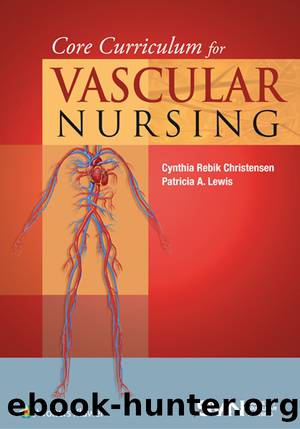Core Curriculum for Vascular Nursing by Christensen Cynthia Rebik;Lewis Patricia A.;

Author:Christensen, Cynthia Rebik;Lewis, Patricia A.; [Christensen, Cynthia Rebik; Lewis, Patricia A.]
Language: eng
Format: epub
ISBN: 2035690
Publisher: Wolters Kluwer
Published: 2014-08-15T00:00:00+00:00
2) Excretion is directly proportional to renal excretory function
3) May be elevated in atherosclerotic RAS (Colyer et al., 2011)
4) Rarely elevated in FMD (Plouin & Bax, 2010)
5) GFR (Dunning & Fischbach, 2011)âThe National Kidney Disease Education Program (NKDEP) recommends that clinical laboratories report an estimated GFR when reporting a serum creatinine
b. Interpretation of findings
1) Normal (Dunning & Fischbach, 2011)
a) Children: 0.3 to 0.7 mg/dL
b) Adults: 0.8 to 1.2 mg/dL
c) Elderly: values may be slightly lower because of decreased muscle mass
2) Abnormal
a) Doubling of creatinine, which suggests a 50% reduction in the GFR
b) Elevation of creatinine, which suggests a chronic disease process
c. AdvantagesâQuick procedure that provides baseline and surveillance monitoring of kidney function
d. Disadvantages
1) Results are influenced by technique and by endogenous and exogenous substances
2) Results are also influenced by age, sex, body weight, muscle mass, diet, and drugs
3) Creatinine levels must be interpreted in conjunction with BUN levels
4) A high protein (meat) diet may cause elevation in creatinine
5) Drugs (aminoglycosides, cimetidine, heavy metal chemotherapeutic agents, and cephalosporins) increase creatinine levels
3. Creatinine clearance
a. DescriptionâUsed to measure GFR of the kidneys as determined through a series of blood tests and a 24-hour urine collection
b. Interpretation of findings
1) The amount of blood present for filtration depends on the ability of glomeruli to act as a filter
2) Filtration is decreased in renal artery atherosclerosis or obstruction
3) When one kidney becomes diseased, the opposite kidney, if functioning normally, can compensate by increasing its GFR; therefore, creatinine clearance will be normal if one kidney has compensated for a stenotic or absent kidney
4) Normal (Dunning & Fischbach, 2011)
a) Males: 94 to 140 mL/min/1.73 m2 or 0.91 to 1.35 mL/s/m2
b) Females: 72 to 110 mL/min/1.73 m2 or 0.69 to 1.06 mL/s/m2
c) Elderly: values decrease 6.5 mL/min/decade of life after age 20 with decline in GFR
c. Advantages
1) Daily production of creatinine depends on muscle mass, which fluctuates very little
2) Creatinine is directly proportional to GFR
d. Disadvantages
1) The amount of filtrate made in the kidney depends on the amount of blood to be filtered and the ability of the glomeruli to filter the blood
2) Unilateral disease may not cause a decrease in creatinine clearance because the normal kidney will compensate
3) Ingestion of large amounts of protein (meat) will increase creatinine levels
4) Requires 24-hour collection of urine
4. Urine specific gravity (Dunning & Fischbach, 2011)
a. DescriptionâIs used to assess the ability of the kidney to concentrate urine. A comparison is made with distilled water, which has a specific gravity of 1.000
b. Interpretation of findings
1) Normal: 1.005 to 1.030 (usually 1.010 and 1.025). Specific gravity varies inversely with the amount of urine excreted (i.e., decreased urine output, increased specific gravity)
2) Abnormal
a) Concentrated urine: >1.025
b) Dilute urine: 1.001 to 1.010
c. Advantages
1) In early renal disease, clinician will see increased volume and decreased specific gravity
2) In hypertension, clinician will see normal volume and decreased specific gravity
d. DisadvantagesâResults are altered by multiple medications (including diuretics and antibiotics), proteinuria, and temperature of the sample
5. Urine protein
a. DescriptionâAssess the severity of renal disease and to assess for nephrotic syndrome
b.
Download
This site does not store any files on its server. We only index and link to content provided by other sites. Please contact the content providers to delete copyright contents if any and email us, we'll remove relevant links or contents immediately.
1610396766 (N) by Jo Ann Jenkins(1580)
Elizabeth Is Missing by Emma Healey(1573)
Economics and Financial Management for Nurses and Nurse Leaders, Third Edition by Susan J. Penner RN MN MPA DrPH CNL(1459)
McGraw-Hill Nurses Drug Handbook by Patricia Schull(1406)
Cherry Ames Boxed Set, Books 1 - 4 by Helen Wells(1336)
NCLEX-RN Prep Plus 2019 by Kaplan Nursing(1321)
Home. by Sarah Graham(1313)
The Language of Kindness by Christie Watson(1307)
Spiritual Midwifery by Ina May Gaskin(1287)
Cherry Ames, Student Nurse by Helen Wells(1280)
Cherry Ames Boxed Set, Books 5 - 8 by Helen Wells(1244)
Whoever Tells the Best Story Wins: How to Use Your Own Stories to Communicate with Power and Impact by Annette Simmons(1240)
Cracking the Nursing Interview by Jim Keogh(1228)
1476763445 by Liz Fenton(1182)
Getting Started with Arduino by Massimo Banzi(1140)
Dementia by June Andrews(1132)
Children's Medicines by Edward A. Bell(1105)
Cherry Ames, Army Nurse by Helen Wells(1091)
Shadows of the Workhouse: The Drama of Life in Postwar London by Jennifer Worth(1061)
